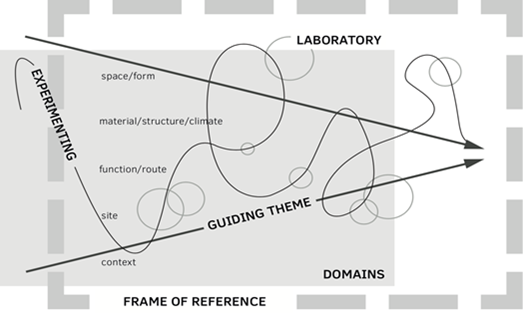Seasoned lecturer Elise van Dooren has taught hundreds of engineering students the tricks of the trade. The educational aspects of her work have always fascinated her. So much so that ten years ago she decided to delve more deeply into a topic that had been occupying her thoughts for a long time: how can aspiring designers gain a better understanding of what designing in itself entails? She developed a framework of five basic concepts that teachers and students can use to embed the often complex design practice in the learning process.
"Teaching is such a beautiful profession.” Van Dooren has been teaching architectural subjects at the Faculty of Architecture and the Built Environment for some thirty years. Like many lecturers, colleagues at the faculty as well as other design programmes, she is trained as a designer, not as a teacher. "During the course of my career, I got the impression we as professionals tend to address students as fellow designers," says Van Dooren. "We manage quite nicely to get them to work towards the result of a design process, i.e. towards a product, but in my opinion, the fundamental thing we should be helping them consider is what the design process itself entails.
Self-confidence
What is expected of me as a designer? How should I tackle this task? If the answers to such fundamental questions initially remain vague or merely implicit, this leads to uncertainty, which Van Dooren knows from her own experience. "As teachers, we need to give students self-confidence by teaching them to think like designers right from the start. I have researched how this can be done and tested it to a certain extent".
Van Dooren took educational subjects at the Open University, and read up on both education and the design process. "Ten years ago, I decided to combine my practical experience and my curiosity into ways of improving this practice in a PhD research project.” She did the research mainly in her own time. "Practising on the job allowed me to let my ideas mature."
Framework
Van Dooren developed a simple framework of five principles, the elementary parts of every design process. These are (in random order): Experimentation, Guiding Themes, Domains, Frame of Reference and Laboratory (visual language). "In the literature, dozens of terms and concepts that mean more of less the same thing are used interchangeably. This creates confusion. What we intend is for these basic concepts – there are only five of them – to give budding designers a framework they can use to navigate the process". In design studios and other educational situations, lecturers can interpret the design process on the basis of these principles and explore it further with their students.
Van Dooren presented the starting points she had distilled from the professional literature to expert designers, who recognised them. "My assumption that little attention is paid to the design process was tested in lessons to first-year students in Delft. After that the concepts were applied in teaching situations, here in Delft and at the Academy of Architecture in Groningen".
Tentative conclusion
The tentative conclusion is that students who are made familiar with the principles do indeed have a better idea of what design means and show more confidence in their own conduct. Van Dooren: "This is a good finding. It would be great to be able to test whether this also happens on a larger scale". Although the framework is based on research into architectural design education, a more general application also seems possible. "Yes, the principles are universal enough to be used in all kinds of design programmes, including technasia.” She plans to convert the thesis into something more accessible and practical. "I haven't figured out exactly what form it will take yet. Suggestions are welcome."

